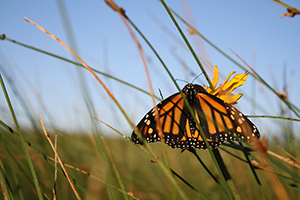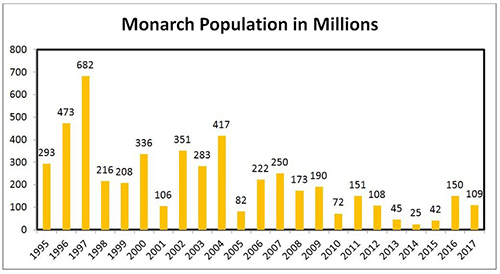10 Things You Might Not Know about Fall’s Annual Monarch Migration
By: Tony Gomez
Posted on:10/30/2018Each August through October, masses of monarchs embark from the southern reaches of Canada on a journey that will take them 2500 Miles to remote mountain treetops in central Mexico.

Each August through October, masses of monarchs embark from the southern reaches of Canada on a journey that will take them 2500 Miles to remote mountain treetops in central Mexico. Millions of overwintering monarchs were discovered roosting there for the first time in 1975. More than beautiful, monarch butterflies also contribute to the health of our planet. While feeding on nectar, they pollinate many types of wildflowers. The flowers they chose are varieties that are brightly colored, grow in clusters, stay open during the day, and have flat surfaces that serve as landing pads for their tiny guests. Monarch butterflies are also an important food source for birds, small animals, and other insects.
1. The Monarchs aren’t going the way of the Dinosaur anytime soon, but…
There is reason to be concerned about the future of the monarch migration as we know it. This year’s population of 124 million monarchs is fewer than half of the long term average of 300 million.
2. The Monarch Population Estimate is Only An Estimate
After an extended fall migration (warm weather) in 2017 and reports of large numbers of migrators entering into the overwintering grounds, many were convinced this would mean a healthy increase for the eastern population last winter. Their impressive arrival was followed by many positive reports on the ground from those who lived near the wintering grounds and those who were visiting them. Many were surprised by the bevy of butterflies that were fluttering through the sanctuaries…a sure sign of good news to follow?!
When the population estimate was finally announced last February, I (and many others) were puzzled to learn the estimated overwintering population was down 20 million. As spring 2018 unfolded, the first Journey North reports from Texas were that they were witnessing perhaps the greatest coastal migration for monarchs…in decades! An increase in sightings followed all through spring and summer…
It’s become clear the 2017-18 monarch population estimate wasn’t even close to accurate, so now we’ve got to stop and wonder…Why? A few questions to consider:
Was the population concentrated in an area that wasn’t covered during the count? Are there additional winter populations located between the southern US and central Mexico? Is there political motivation (endangered species list inclusion) for underreporting? How accurate are current counting methods?

Regardless of the reason, it’s obvious the eastern monarchs took a big step forward in 2018. Your gardening and raising efforts are making a difference…even if the ‘numbers’ say otherwise.
3. Fall Blooming Plants can Attract Hundreds of Migrators!
Some luck is involved in enticing mass monarchs through your garden gates, but by planting flowers like Mist flowers, Liatris ligulistylis, and the Mexican sunflowers.
4. Monarchs Roost on Trees in Clusters that can Number in the Thousands
This culminates in the roost to end all roosts at their Mexican wintering grounds where they number in the millions. Coastal California also has overwintering roost sites in the thousands. The trees are literally covered in a blanket of monarchs. Back in the northern US, monarchs also form nightly roosts as they make their way down to Mexico.
5. Some of the Western Monarchs DO Migrate to Mexico
It was reported at the Monarch Biology and Conservation Meeting (2012) that butterflies tagged out west have been found on the forest floors of the Mexican wintering grounds.
6. Monarch Butterflies Glide in Upper Air Masses called Thermals to Conserve Energy
They ride these thermal waves all the way to Mexico. They fly at speeds ranging between 15-25 mph. One tagged butterfly was recently reported to have traveled 265 miles in one day. Recent flight study revealed that a monarch with 140mg of fat to burn could fly for 44 hours when flapping, but 1,060 hours when soaring and gliding!
7. Monarchs Mysteriously Arrive at the same Remote Wintering Grounds Season after Season
Strangely, none of the returning monarchs have ever been to the wintering grounds before. If there are maps from ancestors in their genetic coding, imagine what this could mean for your monarch butterfly garden at home.
8. The Mexican Forest is not always a Safe Haven!
It’s estimated that more than 15% of the overwintering population will fall victim to predators that pluck them like berries from trees. These predators include black-backed orioles, black-headed grosbeaks, and black-eared mice.
9. The Monarchs that Migrate to Mexico in Autumn are the Same Ones Returning in Spring.
These mature ladies will be seeking fresh milkweed in the southern US to start a new season filled with the magic of monarchs.
10. Migration Monarchs are Massive
While the wingspan of earlier monarch generations is generally 3.5-4″, most of the migrators have wingspans over 4″
 Sign In
Sign In
 Sign In
Sign In
